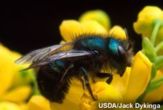How Did Bees Survive Dino-Killing Asteroid?

Tropical honeybees survived the asteroid impact that most scientists agree led to the demise of dinosaurs 65 million years ago. One scientist thinks that's a bit strange.
Researchers aren't sure exactly what mechanisms drove dinosaurs to extinction. The impact itself would have killed a lot of life, but dust and debris kicked high into the atmosphere is thought -- by some scientists -- to have created a years-long winter that disrupted the food chain, making life unbearable for the large beasts. Increased volcanic activity might also have played a role.
Many species besides dinosaurs died out. Yet some endured.
Jacqueline Kozisek decided to look at one survivor that hasn't evolved much since.
Tropical honeybees from the era, preserved in amber, are pretty much identical to their descendents, says Kozisek, a graduate student at the University of New Orleans. Since modern bees could not endure years of dark and cold, it stands to reason their ancestors couldn't have, either.
"It couldn't have been that huge," says Kozisek of the temperature drops theorized by some researchers.
Modern tropical honeybees like things to stay around 88 to 93 degrees Fahrenheit (31-34? Celsius), Kozisek says. That's also the best range for the nectar-rich flowering plants they feed on.
Sign up for the Live Science daily newsletter now
Get the world’s most fascinating discoveries delivered straight to your inbox.
Based on what is known about the climate 65 million years ago, Kozisek estimates that a prolonged temperature drop of more than 4 to 13 degrees Fahrenheit (2-7? Celsius) would have blitzed the bees. Some theories estimate drops of 13 to 22 degrees Fahrenheit after the ancient calamity, she said.
A handful of scientists have used the fossil record, or rather the lack of it, to suggest the asteroid impact did not act alone and might not even have been a major player in dinosaur extinction. Nearly all experts on the subject disagree with that minority view, however.
"I'm not trying to say an asteroid impact didn't happen," says Kozisek. "I'm just trying to narrow down the effects."
Kozisek is presenting her work today at a meeting of the Geological Society of America in Denver.
Robert is an independent health and science journalist and writer based in Phoenix, Arizona. He is a former editor-in-chief of Live Science with over 20 years of experience as a reporter and editor. He has worked on websites such as Space.com and Tom's Guide, and is a contributor on Medium, covering how we age and how to optimize the mind and body through time. He has a journalism degree from Humboldt State University in California.










